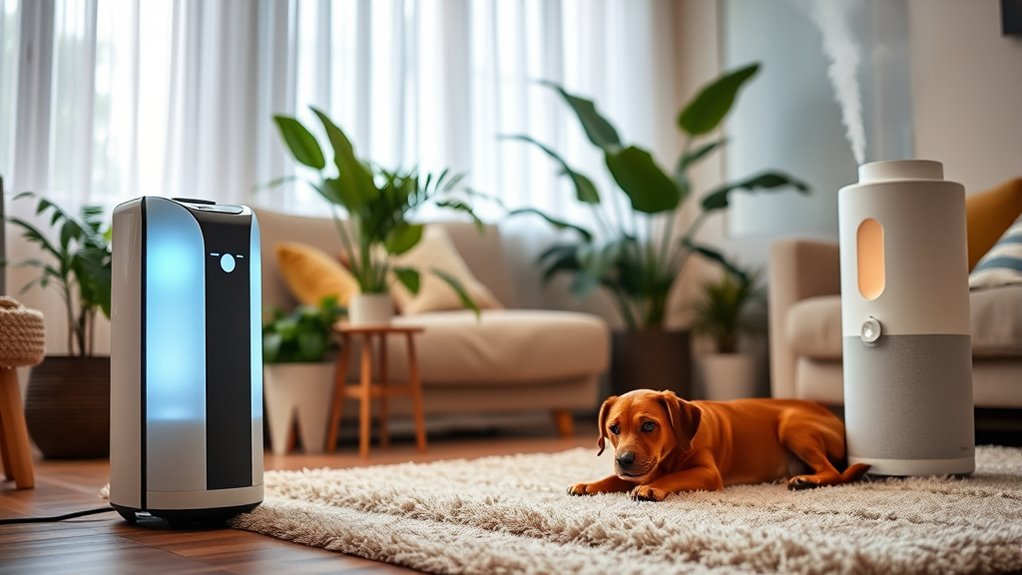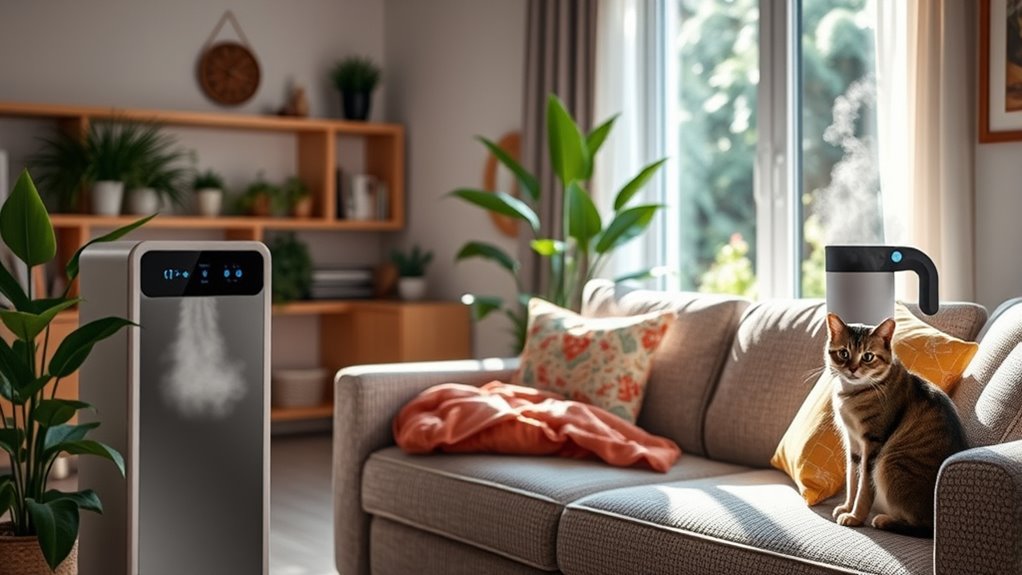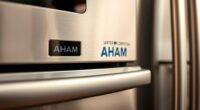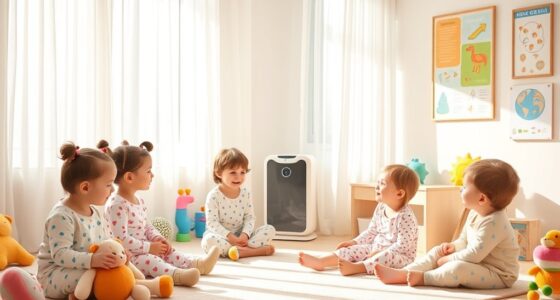To manage pet allergies indoors, choose an air purifier with a HEPA filter to effectively trap pet dander, hair, and other allergens. Make sure it has a high CADR rating and multiple fan speeds for customizable use. Adding a humidifier helps prevent dryness and reduces allergen dispersal if maintained properly between 40-50% humidity. Combining both devices and maintaining them well can considerably improve your indoor air quality—keep going to discover how to optimize their performance.
Key Takeaways
- Choose HEPA air purifiers with high CADR to effectively capture pet dander and airborne allergens.
- Maintain humidity levels between 40-50% with humidifiers to reduce pet dander suspension.
- Place purifiers centrally and humidifiers away from vents for optimal air circulation and even humidity.
- Regularly clean or replace filters and humidifier parts to prevent mold and allergen buildup.
- Use devices with air quality indicators and maintenance alerts for consistent indoor air health.
Understanding Pet Dander and Indoor Air Quality

Pet dander, tiny skin flakes shed by cats, dogs, and other pets, is a common allergen that can considerably impact indoor air quality. Pet fur often traps these allergen particles, making them become airborne easily. When you breathe, pet fur and dander act as allergy triggers, causing sneezing, itchy eyes, and respiratory issues. Even if your pet doesn’t shed much fur, dander can still linger on furniture, clothing, and carpets. These particles are lightweight and can stay suspended in the air for hours, increasing exposure. Without proper ventilation or filtration, pet dander builds up inside your home, worsening allergy symptoms. Understanding how pet fur and dander contribute to indoor air pollution helps you take steps to reduce these triggers and improve your indoor environment. Data-driven strategies can help identify the most effective ways to manage pet allergens indoors.
Features to Look for in Air Purifiers for Pet Owners

When choosing an air purifier for a home with pets, it’s crucial to prioritize features that effectively remove pet dander and other allergens. Look for models equipped with HEPA filters, which are proven to capture tiny particles like pet hair, dander, and pollen. HEPA filters provide allergen capture at a high efficiency, ensuring cleaner indoor air and relief from allergy symptoms. Additionally, select purifiers with a high Clean Air Delivery Rate (CADR) to ensure rapid filtration of airborne pollutants. Consider models with multiple fan speeds for adjustable airflow and easy maintenance features like filter replacement indicators. By focusing on HEPA filters and strong allergen capture capabilities, you’ll create a healthier environment for both you and your pets. Incorporating air quality indicators can also help monitor and maintain optimal air conditions in your space.
The Role of Humidifiers in Managing Allergies

While air purifiers with HEPA filters help reduce airborne allergens, managing indoor humidity levels also plays a key role in allergy relief. Humidifiers can prevent your nose and throat from drying out, making allergy symptoms less severe. To keep your humidifier effective, regular humidifier maintenance is essential—clean it weekly to prevent mold and bacteria buildup. Proper humidity levels (between 40-50%) help reduce pet dander filtration in the air, as dander particles tend to settle when humidity is balanced. Additionally, maintaining a clean humidifier prevents the spread of allergens. Using a humidifier in conjunction with your air purifier creates a healthier indoor environment, easing allergy symptoms and improving comfort for you and your pets. Effective humidifier maintenance is crucial for preventing the buildup of mold and bacteria, ensuring a healthier air quality.
Combining Purifiers and Humidifiers for Optimal Comfort

Combining air purifiers with humidifiers creates a powerful strategy for reducing allergens and enhancing indoor comfort. To maximize their effectiveness, focus on airflow optimization and smart device placement. Place the purifier in a central location to ensure even air circulation, and position the humidifier where it won’t be obstructed. This setup helps prevent dry air and airborne pet allergens from settling. Use the table below for ideal placement tips:
| Device | Placement Tip | Benefit |
|---|---|---|
| Air Purifier | Near the pet’s favorite spot | Better allergen removal |
| Humidifier | Away from vents and electronics | Even humidity distribution |
| Both Devices | On different levels of the room | Improved airflow and coverage |
An additional consideration is avoiding ineffective purification by properly selecting and maintaining your devices.
Tips for Maintaining Your Indoor Air Quality Devices

Regularly maintaining your indoor air quality devices guarantees they operate efficiently and effectively remove pet allergens. Start with air filter maintenance by replacing or cleaning filters as recommended by the manufacturer. This prevents buildup and ensures ideal allergen tracking, so your purifier can do its job properly. Keep an eye on filter indicators and set reminders for regular checks. Regularly inspecting and cleaning vents and humidifier components prevents mold and dust accumulation. Monitoring allergen levels in your home helps you identify when filters need changing or if additional cleaning is necessary. Proper maintenance not only prolongs the life of your devices but also guarantees they continue to improve your indoor air quality, reducing pet allergens and creating a healthier living environment. Incorporating smart technology features can also help you monitor device performance remotely and receive alerts for maintenance needs.
Frequently Asked Questions
How Often Should I Replace Filters in My Air Purifier?
You should check your air purifier’s filter maintenance and follow the replacement schedules recommended by the manufacturer. Typically, filters need replacing every 3 to 6 months, but this can vary depending on usage, air quality, and pet dander levels. Regularly inspect your filters, and if they look dirty or clogged, replace them sooner to guarantee peak performance and clean indoor air for you and your pets.
Can Humidifiers Spread Bacteria if Not Cleaned Properly?
Imagine a family using a humidifier daily without cleaning it regularly. Bacterial growth can thrive in moist environments if not cleaned frequently, risking bacteria spreading through the air. Proper cleaning frequency is essential to prevent this. If you neglect cleaning your humidifier, you might unknowingly introduce bacteria into your indoor air, compromising your health. Regular cleaning disrupts bacterial growth, ensuring your humidifier remains safe and effective.
Are There Specific Air Purifiers Effective Against Pet Odors?
You’re wondering if certain air purifiers work better for pet odor elimination. The good news is, some air purifiers are specifically designed for pet odors, featuring activated carbon filters that absorb smells effectively. To maximize air purifier effectiveness, choose one with a HEPA filter combined with activated carbon. Regular maintenance, like changing filters, also guarantees ongoing pet odor elimination and keeps your indoor air fresh and clean.
What’S the Ideal Humidity Level to Reduce Pet Allergies?
Think of your home as a sanctuary, where ideal humidity levels play a crucial role. Keeping humidity around 40-50% helps prevent pet allergens from becoming airborne, making allergy prevention easier. Too dry, and allergens linger; too humid, and mold might thrive. By maintaining this balance, you reduce pet allergy symptoms, creating a healthier environment for both you and your furry friends. Stay vigilant, and your home stays allergy-free.
Do Certain Materials in Humidifiers Help Trap Pet Dander?
Certain humidifier materials can improve pet dander filtration by capturing tiny particles more effectively. For example, humidifiers with antimicrobial or HEPA-like filters help trap pet dander and prevent it from circulating in your indoor air. Using materials like activated carbon or specialized filters enhances pet dander filtration, making your indoor environment healthier. So, choose humidifiers with these features to reduce pet allergens and improve air quality in your home.
Conclusion
So, now you’re basically an indoor air quality expert—congratulations! Just remember, choosing the right purifier and humidifier isn’t rocket science, even if it sometimes feels like it. Keep those devices clean, and your nose will thank you. After all, who needs fresh air when you can just buy more gadgets, right? Just kidding—trust your new knowledge and breathe easy, pet lover. Your lungs will thank you, and so will your furry friend’s fur.









